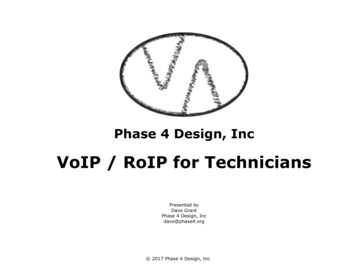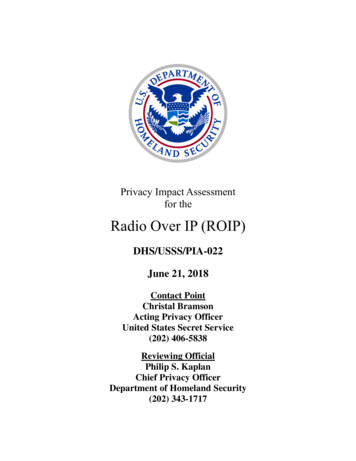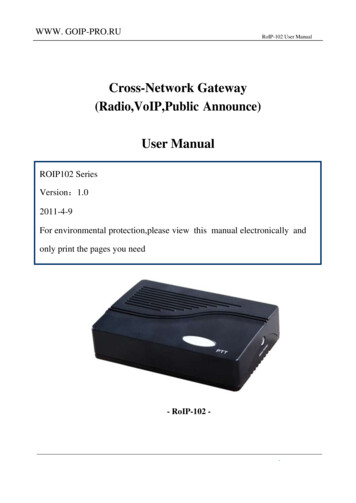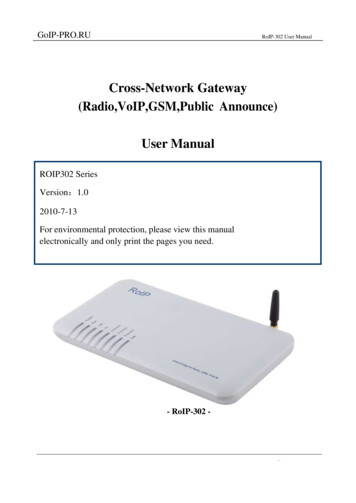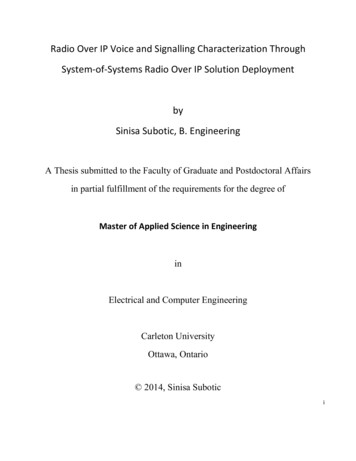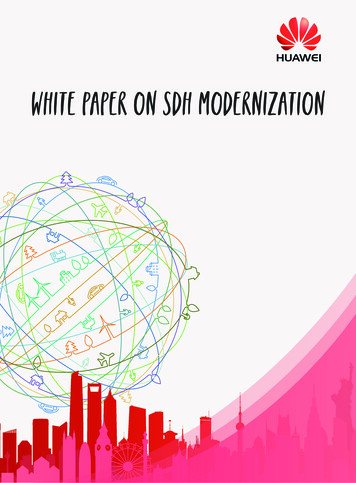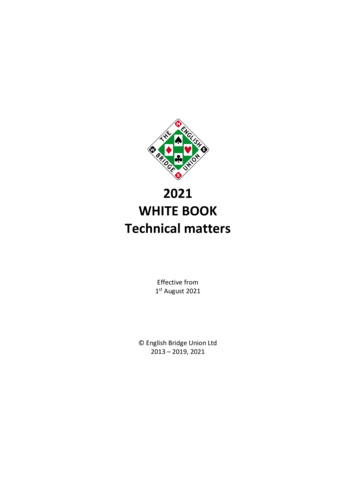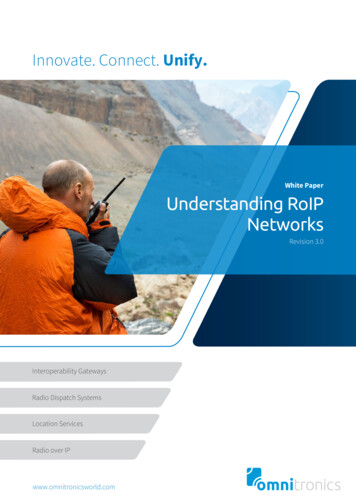
Transcription
Innovate. Connect. Unify.White PaperUnderstanding RoIPNetworksRevision 3.0Interoperability GatewaysRadio Dispatch SystemsLocation ServicesRadio over IPwww.omnitronicsworld.com
White PaperUnderstanding RoIP NetworksIntroduction to Radio over IP (RoIP)Radio over IP describes the application of Voice over Internet Protocol technology to the two-way radio. It is ageneric term and does not describe any specific implementation or standard. This paper will focus on howRoIP is implemented using standard Internet Protocols for voice and what issues may be encountered. Someof these issues also apply to proprietary RoIP systems.RoIP can deliver several key benefits to fleet mobile operators, including public safety organizations. Theseinclude: lower costs, improved reliability and increased interoperability. All of these are derived from theability of the technology to utilize existing IP infrastructure - the IP backbones that make up both local andwide area networks.VoIP was designed to provide a telephone replacement. It allows a large service provider to connect manyusers for voice communications on demand. This is different to the typical ways that Radio over InternetProtocol is used.The RoIP DifferenceVoIP and RoIP use the same mechanism to transmit voice or audio data. However, radio and telephony differwhen it comes to signalling and control.TelephonyRadio Focus is Call Setup, Monitoring and Control Focus is on Instant Communication, monitoringand control Generally one-to-one Generally one-to-many Always full duplex Generally half duplex, although full duplex isbecoming more common Typically a large Telco is the service provider Typically the organization itself manages theirservice Central Telco Server Peer-to-peer service Minimal customisation Specific to customer Capabilities required include passing dial tones,DTMF strings and call process tones Significant extra capabilities as listed below.Additional Radio Capabilities:General radio signalling information: Push to Talk (PTT): Indicates the radio should transmit and must be synchronized with the audio.Carrier Operated Switch (COS) from the radio: Used to generate a busy signal or key-up anothertransceiver at the remote end.For Analog Radio: 2Tone Information: DTMF, Paging Tones, SELCALL, EIA TonesContinuous Tone Coded Squelch System (CTCSS)In-band Guard tonesRadio channel frequency changewww.omnitronicsworld.com
White PaperUnderstanding RoIP NetworksFor Digital Radios Type of radio call in progress (Broadcast, Group or Individual calls)Radio IdentificationAdvanced Radio Features: Stun, Revive, Remote Monitoring, EmergencyRadio channel profile change (includes frequency and other operating parameters).ApplicationsRadio over IP can be used in several ways to leverage radio systems. Some applications include: Access to remote radiosPoint-to-point radio interconnection, also point to multipoint and cross-bandingRadio to Dispatch Console linksRadio to Phone gatewayUsing existing infrastructure to reduce cabling.Remote AccessFor further details on typical applications, see our other White Paper: VoIP for Radio Networks.VoIP StandardsThe two key VoIP standards defined by the Internet Engineering Task Force (IETF) are1. Session Initiation Protocol (SIP) – described in RFC 32612. Real Time Protocol (RTP) – described in RFC 3550 / RFC 3551.There are many other standards that are relevant to voice and multimedia communications. However, SIP andRTP are the two key protocols that do most of the heavy lifting.Using existing VoIP standards for implementing RoIP provides several key advantages. These are: Improved Vendor-independent InteroperabilityEasy Integration with Existing Phone and Voice SystemsCompatibility with off-the-shelf Voice RecordersRecognized by Routers, Firewalls and Network Tools.The disadvantages to using standards are that they are more complicated and also do not support all of theradio information that is required.Session Initiated Protocol (SIP)SIP is a standard protocol used to set up VoIP calls. The purpose of SIP is to make communication possible. It: Determines the IP address of the Remote DeviceDetermines the UDP Port Numbers to use for RTPNegotiates what Features can be used (e.g. the Audio Codecs)It is only used to make and break connections. No audio is transmitted via SIP.3
White PaperUnderstanding RoIP NetworksTypes of SIP Devices SIP User Agents: End-user devices that create and manage a SIP session. A radio to VoIP gateway suchas the Omnitronics IPR110Plus or a SIP VoIP phones are examples SIP. SIP Servers: There are various types of SIP servers that provide different functions. The two mostimportant server types are:1. Registrar Server: Stores the devices registration information in a database. This can be local orprovided by yet another server. This database is searched to find devices to which a connectionmay be made. It also authenticates the SIP device to ensure it supplies the correct credentials,namely user name and password.2. Proxy Server: Usually used to re-route requests or messages.A SIP server may be both a registrar and a proxy server at the same time.SIP is a text based protocol similar to the Hyper Text Transfer Protocol (HTTP) used for transferring data overthe Internet/world wide web (www). The protocol consists of requests and responses.INVITE sip:bob@biloxi.com SIP/2.0Via: SIP/2.0/UDP pc33.atlanta.com;branch z9hG4bK776asdhdsMax-Forwards: 70To: Bob sip:bob@biloxi.com From: Alice sip:alice@atlanta.com ;tag 1928301774Call-ID: a84b4c76e66710@pc33.atlanta.comCSeq: 314159 INVITEContact: sip:alice@pc33.atlanta.com Real Time Protocol (RTP)RTP is a standard protocol for delivering audio and video over IP networks. RTP is used in communication andentertainment systems such as telephony, video teleconferences and television. It: 4Is designed for end-to-end, real-time transfer of stream data. The protocol includes features tocompensate for problems that result from sending streams of data over unreliable packet switchingnetworks.Prioritizes “Real-time” over Reliable: It is more important for the data to arrive on time than it is toguarantee that 100% of the data is delivered.Provides data transport not any mechanism to setup the link.Can send voice and radio information but when used in this manner it requires more systemconfiguration and is less flexible.Can be used for point-to-point links (unicast) or point-to-multipoint (multicast).Includes facilities for detecting issues that may occur when sending data over packet switchingnetworks such as:o Detection of last data packetso Coping with packets arriving in the wrong ordero Coping with variable delays in packet delivery (Packet Jitter)www.omnitronicsworld.com
White PaperUnderstanding RoIP NetworksCommon VoIP IssuesDelayThere are two types of delays that occur within packet switched networks: Constant Delays or LatencyVariable Delays resulting from the Nature of Packet Switching. Usually described a “Jitter Delay”To compensate for Jitter Delay, the end device needs to keep a buffer of audio data so that it can continue toplay audio even if the next packet is a little late to the party. This in itself can be another source of delay.When looking at the total delay the following sources need to be considered:1. Digital to Analogue Conversions2. Framing Delay (Audio Data is collected into afix duration packet, typically 20 milliseconds orsome multiple of 20 milliseconds)3. Software Processing which time taken toEncode or Decode the Audio4. Fixed Network Delay5. Variable Network Delay (Jitter)6. Jitter buffering delayPortable mobile radio systems are usually half-duplexwith a Push to Talk (PTT). This means that radiosystem can tolerate delay better than telephonesystems. However, the RoIP system must ensure thatthe Push to Talk signalling is synchronized with audioso that no leading or trailing syllables get cut off.Figure 1: Sources of delay in VoIPIn Telephone systems, most callers notice round-trip delays when they exceed 250 milliseconds, so the oneway latency budget would typically be 150 milliseconds. 150 milliseconds is specified in ITU-T G.114recommendation as the maximum desired one-way.However, in some applications, such as radio set-ups with multiple chained repeaters, the audio delay canactually be desirable. By delaying the audio relative to the Push to Talk signal, the first spoken syllable is notlost.5
White PaperUnderstanding RoIP NetworksEchoWithout delay, echo is not usually an issue. However, once a delay has been added, the echo becomesperceptible to system users. This can be an issue in two common scenarios: Telephone 4 wire to 2 wire hybrids: When interfacing to a 2-wire phone system the hybrid circuits canproduce significant echoOperator Crosstalk in an operations centre where multiple operators are communicating withcommon radio channels. The operators may be able to hear the audio from other operators withadded network delay.Eliminating EchoEcho can be eliminated in some cases using Digital Signal Processors (DSP) to process the audio. Echocancellation algorithms use an adaptive filtering algorithm to remove the echo signal from the received audio.The DSP algorithm uses an adaptive filter to remove the echo signal and can take a perceptible time toconverge and cancel the echo. DSP based echo cancelling can affect audio quality during “double talk” (whenboth parties talking at the same time on a full-duplex link).Packet LossOn real world networks packets sometimes don’t make it through. However, voice is generally intelligible evenwith quite high levels of packet loss as VoIP systems incorporate Packet Loss Concealment (PLC) algorithms tocompensate.On wired networks such as LANs or WANs, packet loss generally only occurs as a result of systems beingoverloaded or congested. However, other links are subject to loss of individual packet, such as WIFI networksor Microwave links.Generally, well designed RoIP systems should provide intelligible audio with very high levels of packet loss.Packet loss of 10% or less should still provide acceptable audio quality. However, effective communicationsmay be dependent on other mechanisms (such as TCP/IP based mechanisms) that may not be as tolerant ofpacket loss.Coder Decoders (CODECS)Radio and Telephony use the same mechanisms to transport voice through packet switched data networks.At the transmitting end voice is converted into digital data, assembled into data packets and transmitted atregular intervals. Typically, these intervals are 20 milliseconds or some multiple of it.At the receiving end the digital data is collated and converted back to into an analog signal. Generally, VoIP /RoIP systems use a sample rate of 8000 samples per second and single channel (mono) audio.Software codecs take digitized audio and encode it into a form that is efficient to send over the network. Theycompress the audio so less data is required to transmit it. Generally, the codecs used for VoIP are lossy (i.e. thecompression is achieved by discarding some of the audio information meaning a loss in the quality of theaudio).6www.omnitronicsworld.com
White PaperUnderstanding RoIP NetworksThe codecs used for real time communications must be low latency, they need to be able to process the audioin real time (a codec only has 20 milliseconds to encode or decode 20 milliseconds of audio). Codecs such asMP3 don’t have to encode the audio in real-time so they can achieve better compression and audio quality.However, they still need to decode in real time.Widely used Codecs for VoIP and RoIPCodecBits per SecondNotesG.71164 000 (8 bit, 8kHz)Most widely used CodecG.72648 000, 32 000, 24 000 or 16 000Adaptive Differential Pulse Code Modulation (ADPCM)GSM13 2002G Mobile Phone StandardG7.298 000Used in a lot of VoIP SystemsIMBE7 200“Improved Multi Band Excitation”AMBE3 600“Advanced Multi Band Excitation”. Widely used in digitalradio standards. Includes Error Correction.ACELPTETRAAlgebraic Code Excide Linear Prediction7 2000The more modern codecs (G.729, IMBE, AMBE and the ACELP) used in digital radio are covered extensively bypatents. The licensing costs associated with using these technologies are significant.Recently there have been several low bandwidth narrowband codecs developed that are not covered bypatents and being made available royalty free. Examples of these are BroadVoice16 (ITU J.161) and ITU G.718.7
White PaperUnderstanding RoIP NetworksNetwork Protocol OverheadIf RTP is used to transmit the audio, there is an overhead caused by the network protocols used to transmitthe data. If the data is sent over an Ethernet LAN the overhead typically consists of:ProtocolOverhead (in bytes)Overhead (in bytes)Real Time Protocol (RTP)1212User Datagram Protocol (UDP)88Internet Protocol (IP)2020-384078EthernetTotalWith a packet size of 20 milliseconds, the overhead for the network layers becomes significant. In the case ofthe high compression codecs, the overhead is actually larger than the payload.Codecs and Tone TransportOne issue for analog radio system and the high compression codecs is that the codecs have been optimized forspeech signals. As a result, they can affect the fidelity of tones passed through them.Codecs that compress the audio can result in tones being distorted. This means they cannot be reasonablycompressed. And since one of the goals of VoIP is to reduce IP bandwidth through high compression, VoIP andradio signalling are not compatible. Hence, Radio over IP must transport signalling tones as data messages andnot as audio. Similarly, if CTCSS tones are to be transported over an IP network then they should also beconverted into data messages.In both cases, the equipment that provides the interface between the radio and the IP network must be capableof decoding the CTCSS, SELCAL or ANI audio and converting these into data messages. When receiving a datamessage containing a signalling string, the same equipment must also be capable of encoding this into theappropriate audio tones.The problem of passing signalling schemes can be further compounded by the inherent packet losses within IPnetworks. When passing voice, a low rate of packet loss is not usually an issue. However, when lost packetscontain tone signals, it can result in breaks in the continuous tone, which will cause tone detectors to stoprecognising the tone.Ultimately, the most reliable way to transmit signalling schemes and tones through IP is to use a messagingprotocol that is transparent to the end user equipment. Most of the radio functions that require tones have beenreplaced by digital functionality. The exception is audible alarms – such as a site wide emergency tone.8www.omnitronicsworld.com
White PaperUnderstanding RoIP NetworksIP Connectivity MethodsThere are a number of methods of connecting Radios over IP and this will depend on your IP network.User Datagram ProtocolTypically, RTP is sent using UDP as the transport protocol. UDP is the simplest of the IP protocols as it providesfor simple, stateless delivery of data packets. However, as it does not provide any mechanism for detectingand resending lost packets it can be unreliable. The RTP layer must detect and cope with information or audiodata loss.Transmission Control PanelAnother widely used transport layer Internet Protocol is TCP which is a reliable delivery guaranteed protocol.For RTP, however, TCP is not appropriate. The main problem with TCP is that if a packet is lost the TCP layerwill stop delivering data until that lost packet has been successfully resent, resulting in large delays. In otherwords, TCP prioritizes reliability over real-time.MulticastingIn computer networking; multicasting is a mechanism to send information to a group of hosts simultaneously.Multicast uses network infrastructure efficiently by requiring the source to send a packet only once, even if itneeds to be delivered to multiple receivers. The routers in the network take care of replicating the packet toreach multiple receivers only when necessary. Ultimately this means greater bandwidth efficiency.However, there are some issues that can mean multicasting can be difficult to implement: Multicasting does not work on the general Internet as ADSL routers do not support multicasting.In a WAN, all the routers in the network have multicasting enabled for multicast to workConfiguring network routers to use multicasting is a complex task.ConferencingIn situations where multicasting is not practical, a similar effect can be used by creating multiple unicast linksto create a conference or party line.By using Omnitronics’ proprietary conferencing mode multiple RoIP adaptors can communicate with all otheradaptors within the conference. Unlike multicast addressing which uses a one-to-many relationship,conferencing is peer-to-peer. In essence, this is a simulated multicast mode. Delay is also minimized by simplypassing packets through rather than decoding them.Whilst this peer-to-peer arrangement may be simple to implement, it can become impractical for largernetwork configurations. This is because the number of links that need to be configured grows exponentiallywith the number of radios.To avoid creating such complex configuration scenarios, the RoIP adaptor purposely limits the number ofremote radios that can be used in this conferencing mode. In a case where more than 5 radios need to belinked, one of the RoIP adaptors can be setup as a bridge server linking two conference groups.9
White PaperUnderstanding RoIP NetworksComparison TableConnectionMethodUnicast Real TimeProtocol (RTP)Multicast RTPAdvantages Constantly connected - if the IPlink fails at any time, it can beimmediately detected by theconsole software and warn theuser. Requires static IP addresses for allparties - there couldbe additional cost from IT serviceproviders as Dynamic Addressingis not used Can be used over the Internet - asit can be configuredto work via Network AddressTranslation (NAT). Limited Operator Positions - dueto the point-to-point nature ofthe protocol Greater Configuration of EndDevices -especially when multipletransmit destinations arerequired. Constantly connected Bandwidth efficiency – moreVoice Paths can be transportedthe same IP network thanother.Won’t work over the Internet –LAN/WAN Only Complex Setup - Many ITadministrators will not allowmulticasting schemes over theLAN or WAN. All Network Devices need toSupport Multicast - This could becostly and time consuming Difficult to Identify PotentialProblems – when used with morethan a single unmanaged switchon a LAN 10DisadvantagesSimplified Configuration –through the use of Dynamic IP(DHCP)Supports More Consoles & EndPoints – on the same IP Networkwww.omnitronicsworld.com
White PaperUnderstanding RoIP NetworksSecessioninitiated Protocol(SIP)OmnitronicsUniqueConferencingMode Connected only when required the IP network is freed up to beused by other devices therebyreducing overall bandwidthrequirements. Simplified Configuration –through the use of Dynamic IP(DHCP) & there is no need toconfigure the destinationaddresses of the receiving units. Enables Point-to-MultipointComms - without the need formulticast support. Reduced Router Configuration to achieve the same result asmulticast. Can be used over the Internet - asit can be configuredto work via Network AddressTranslation (NAT). Doesn’t work well where there isBad Packet Loss if the IP link fails at any time,it cannot be immediatelydetected by the console software& warn the user, withoutconsiderable overhead. Can have issues with NAT andFirewalls. Many IP networks are not‘naturally configured for SIP Firewalls will prevent the SIPpackets passing through therouter and stopping a link beingmade. Requires static IP addresses Restricted to a Smaller Number ofDevices Greater Configuration at the EndDevices - as compared to SIP orMulticast. Less bandwidth efficient thanmulticasting.11
White PaperUnderstanding RoIP NetworksA Final Note on Digital RadioDigital radios with IP connectivity are types of Radio over IP. In fact some of these standards that are based onthe SIP and RTP protocols this paper has described. In particular DMR-AIS, APCO P25 DFSI, ISSI and CSSIstandards use of both RTP and SIP.However, there are several problems with connecting digital radio systems together over IP.1. Firstly there is the problem that there are several standards and none of these standards areinteroperable.2. None of the current Digital radio protocols use widely implemented or freely available Codecs (eventhose that use RTP and SIP).One solution is to the above is to continue to use gateways to aid this interconnection over IP, providing thishigher network functionality. However you must ensure that those gateways have been designed to transmitthe added digital radio data and functionality.This gateway approach also provides a number of other benefits. This includes: Digital Radios with Point-to-Point Protocols can be Shared Amongst a Number of Operator PositionsOnly ONE vocoder is required (and located in the gateway) and shared amongst a number of usersGateways allow the Radio to be accessed simultaneously by a mixture of dispatch consolesGateways provide organizations with the flexibility to change protocols to meet future demandsGeneral terms of use for Omnitronics technical documentation: While Omnitronics has taken every care to ensure that the information and contents arecorrect and up-to-date at the time of printing, the information may contain technical inaccuracies and/or printing errors. Omnitronics does notguarantee the accuracy or correctness of the information. Omnitronics cannot be held liable or responsible for errors or omissions in the contents ofthe technical documentation. All information contained in the technical documentation is given without warranties or representations, expressed orimplied.Disclaimer: Omnitronics expressly disclaims all warranties, expressed or implied, including but not limited to implied warranties as to the accuracy ofthe contents of this document. In no event shall Omnitronics be liable for any injury, expenses, profits, loss or damage, direct, incidental, orconsequential, or any other pecuniary loss arising out of the use of or reliance on the information described in this document.Copyright 2020 Omnitronics.12www.omnitronicsworld.com
Innovate. Connect. Unify.www.omnitronicsworld.com
Radio over IP . White Paper Revision 3.0 . Understanding RoIP Networks. 2 . White Paper . www.omnitronicsworld.com. Introduction to Radio over IP (RoIP) Radio over IP describes the application of Voice over Internet Protocol technology to the two -way radio. It is a generic term and does not describe any specific implementation or standard .
